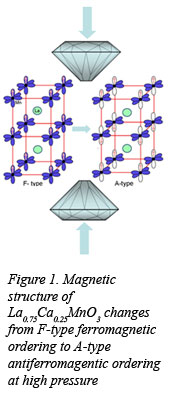 Understanding and ultimately controlling the intricate coupling between electrical conductivity and magnetism in colossal magnetoresistance (CMR) manganites remains a challenge, due to the coupling between lattice, charge, spin, and orbital degrees of freedom. Scientists from Carnegie, APS and Argonne, led by Yang Ding (HPSync) report new progress in using high pressure techniques to unravel its subtleties, with recent work showing that the CMR manganite (La0.75Ca0.25MnO3) is subject to a magnetic transition coupled with a Jahn-Teller distortion at approximately 23 GPa.
Understanding and ultimately controlling the intricate coupling between electrical conductivity and magnetism in colossal magnetoresistance (CMR) manganites remains a challenge, due to the coupling between lattice, charge, spin, and orbital degrees of freedom. Scientists from Carnegie, APS and Argonne, led by Yang Ding (HPSync) report new progress in using high pressure techniques to unravel its subtleties, with recent work showing that the CMR manganite (La0.75Ca0.25MnO3) is subject to a magnetic transition coupled with a Jahn-Teller distortion at approximately 23 GPa.
To study the material, the researchers used x-ray magnetic circular dichroism (XMCD) and angular-dispersive diffraction techniques at the APS. XMCD is a newly- developed technique that uses high-brilliance, circularly polarized x-rays to probe the magnetic state of materials under pressure in the diamond anvil cell.
The current study shows that the predominant effect of the applied external pressure is an increase in the strength of the superexchange interaction relative to the double exchange interaction. As a result, the system tends to increase the number of through-bond antiferromagnetic interactions by decreasing the dimension of the ferromagnetic region from three to two. This leads to an anisotropic redistribution of the 3d-eg electrons in the Mn atoms.  The resultant non-uniform electron density couples to the lattice via the Jahn-Teller effect causing a strained distortion of the crystal structure even under a uniform hydrostatic pressure. Ultimately, manganite transforms from an F-type ferromagnet to an A-type antiferromagnet at 23 GPa.
The resultant non-uniform electron density couples to the lattice via the Jahn-Teller effect causing a strained distortion of the crystal structure even under a uniform hydrostatic pressure. Ultimately, manganite transforms from an F-type ferromagnet to an A-type antiferromagnet at 23 GPa.
This discovery once again highlights the key role of pressure in understanding the physics of magnetism in dense matter. The results of this study have been published in Physics Review Letters [Y. Ding, et al., Phys. Rev. Lett., 102, 237201 (2009)].
